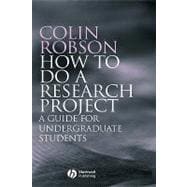
Note: Supplemental materials are not guaranteed with Rental or Used book purchases.
Purchase Benefits
What is included with this book?
| Acknowledegments | |
| Introduction | |
| Making preparations | |
| Project planning checklist | |
| Preliminaries | |
| Recognizing realities | |
| As a student on a course | |
| If you are by yourself | |
| If you are doing this as part of your job | |
| To everybody | |
| Making it worthwhile | |
| Considering your audience(s) | |
| Individual or group research? | |
| Types of group research | |
| Support groups | |
| Working together successfully | |
| Project milestones | |
| The structure of the book | |
| End-of-chapter tasks | |
| Further reading | |
| tasks | |
| Approaches to research | |
| A concern for truth | |
| Different purposes of research | |
| Description | |
| Exploration | |
| Explanation | |
| Emancipation | |
| Research design | |
| The qualitative/quantitative divide | |
| Fixed and flexible designs | |
| Fixed designs | |
| Flexible designs | |
| Overview of some different research traditions | |
| Action research | |
| Case studies | |
| Documentary analysis | |
| Ethnographic research | |
| Evaluation research | |
| Experiments | |
| Grounded theory studies | |
| Surveys | |
| A note on feminist research | |
| Choosing an approach | |
| Further reading | |
| tasks | |
| Developing your ideas | |
| Selecting a topic | |
| Replication research | |
| From a topic to research questions | |
| From research questions to a research design | |
| Do I really need research questions? | |
| Hypotheses | |
| Developing the design | |
| Finding and using sources | |
| Planning the search for sources | |
| Internet searching | |
| Library searching | |
| Asking the author | |
| Dealing with the sources | |
| Ethical considerations | |
| Ethics committees | |
| Ethics guidelines | |
| Avoiding the unethical | |
| Confirming your choices | |
| Further reading | |
| tasks | |
| Selecting the method(s) of collecting data | |
| Trustworthiness and credibility | |
| Reliability | |
| Validity | |
| Research arguments | |
| Data collection methods | |
| Interviews | |
| Fully structured interviews | |
| Semi-structured interviews | |
| Unstructured interviews | |
| Group interviews | |
| Telephone interviews | |
| Using interviews in your project | |
| Questionnaires and diaries | |
| Questionnaires | |
| Diaries | |
| Using questionnaires or diaries in your project | |
| Tests and scales | |
| Using tests or scales in your project | |
| Observation - structured and participant | |
| Structured observation | |
| Participant observation | |
| Using observation in your project | |
| Using documents and other secondary sources | |
| Library research | |
| Unobtrusive measures | |
| Using documents in your project | |
| Other methods | |
| Using multiple methods | |
| Which method? | |
| Further reading | |
| tasks | |
| Doing it | |
| Practicalities of data collection | |
| Sampling and sample sizes | |
| Representative samples | |
| Non-probability samples | |
| Informed consent | |
| Laboratory research | |
| Gaining access for field research | |
| Formal and informal contracts | |
| Getting on and getting out | |
| Insider research | |
| Pilots | |
| Collecting the data | |
| What to do if you run into difficulties or out of time | |
| Further reading | |
| tasks | |
| Making something of it | |
| Analysing and interpreting your findings | |
| What this chapter tries to do | |
| Preparing for analysis | |
| Quantitative (numerical) data | |
| Categorical variables | |
| Ordered categorical variables | |
| Summarizing and displaying categorical data | |
| Continuous variables | |
| Calculating summary statistics with continuous variables | |
| Calculating variability | |
| Displaying continuous variables | |
| Statistical tests and statistical significance | |
| Effect sizes | |
| Clinical significance | |
| What test do I use? | |
| Qualitative data | |
| Data reduction and organization | |
| An example - the grounded theory approach to analysis | |
| Using specialist computer packages for qualitative data analysis | |
| Summary of qualitative data analysis | |
| Interpretation - what is going on here? | |
| Further reading | |
| 6 tasks | |
| Writing the report | |
| Planning and drafting | |
| Research arguments | |
| Claims | |
| Reasons and evidence | |
| Considering your a | |
| Table of Contents provided by Publisher. All Rights Reserved. |
The New copy of this book will include any supplemental materials advertised. Please check the title of the book to determine if it should include any access cards, study guides, lab manuals, CDs, etc.
The Used, Rental and eBook copies of this book are not guaranteed to include any supplemental materials. Typically, only the book itself is included. This is true even if the title states it includes any access cards, study guides, lab manuals, CDs, etc.